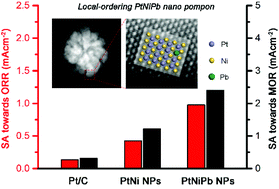Locally-ordered PtNiPb ternary nano-pompons as efficient bifunctional oxygen reduction and methanol oxidation catalysts†
Abstract
To accurately control the composition and structure of Pt-based alloys is essential for engineering highly active and stable catalysts, yet challenging. Here, ternary PtNiPb nano pompons (NPs) combining the features of a highly open structure, local-ordering and the introduction of Pb have been synthesized via a seed-mediated growth method. Taking advantage of the reduction potential differences, gradient distribution of Pb and Ni throughout the NPs is realized, and both the elemental composition and distribution can be facilely regulated by reaction time. The PtNiPb NPs exhibit much enhanced catalytic performance for both the oxygen reduction reaction (ORR) and methanol oxidation reaction (MOR), of which the ORR specific activity is 7.4- and 2.3-fold larger than those of the commercial Pt/C catalyst and binary PtNi NPs. Density functional theory (DFT) calculations reveal that the weak coupling between Pb-p and Pt-d orbitals together with the regulation of the over-compressed Pt surface by the local-ordering structure and embedded Pb atoms optimize the surface oxygen adsorption character and eventually boost the ORR.



 Please wait while we load your content...
Please wait while we load your content...